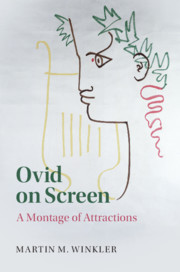Book contents
- Ovid on Screen
- Ovid on Screen
- Copyright page
- Dedication
- Contents
- Illustrations
- Acknowledgments
- D M
- Adages
- Fade-In: Prooemium
- Part I Theory and Practice
- Part II Key Moments in Ovidian Film History
- Part III Into New Bodies
- Part IV Love, Seduction, Death
- Part V Eternal Returns
- Chapter 10 Immortality: Philosophy, Cinema, Ovid
- Chapter 11 Ovidian Returns
- Sphragis: End Credits
- Bibliography
- Passages of Ovid’s Works
- General Index
- Plate Section (PDF Only)
Chapter 11 - Ovidian Returns
from Part V - Eternal Returns
Published online by Cambridge University Press: 27 January 2020
- Ovid on Screen
- Ovid on Screen
- Copyright page
- Dedication
- Contents
- Illustrations
- Acknowledgments
- D M
- Adages
- Fade-In: Prooemium
- Part I Theory and Practice
- Part II Key Moments in Ovidian Film History
- Part III Into New Bodies
- Part IV Love, Seduction, Death
- Part V Eternal Returns
- Chapter 10 Immortality: Philosophy, Cinema, Ovid
- Chapter 11 Ovidian Returns
- Sphragis: End Credits
- Bibliography
- Passages of Ovid’s Works
- General Index
- Plate Section (PDF Only)
Summary
Chapter 11 extends the subject of the preceding chapter by returning to Ovid’s Orpheus, Icarus, and Medusa. It begins with Jean Cocteau, who dealt with the myth of Orpheus in three thematically related films and addressed Orphic themes in other works. As mythic-creative character, Orpheus was Cocteau’s closest model. Poetic immortality is Cocteau’s chief concern, as is love beyond death. Statues play an important part in this. The chapter then turns to French critic André Bazin, who regarded the Icarus myth as an analogy to the nature of cinema as an idealistic phenomenon. A number of films with references to Icarus’ flight support Bazin’s thesis. Had Ovid not told his story, Icarus would have been all but forgotten. The cinema keeps his memory alive, especially in futuristic contexts. Icarus’ appearances in science-fiction films tell us that Ovid’s tale has lost none of its fascination. Thirdly, the cinema may be regarded as a benign Medusa Effect, through which actors become icons, if not necessarily statues, of themselves. All this, like much of the material dealt with in preceding chapters, is in essence marvelous, a quality that D’Annunzio had postulated as a major element in ancient art and that the cinema has revived spectacularly. “It’s a very old story,” we are told in Black Orpheus, which updates the myth of Orpheus and Eurydice to its own time and transports it into the New World. The myth is always renewable, as this film’s Orpheus observes: “There was an Orpheus before me, and one may come after I’m gone.” The eternal return of myth, especially of Ovidian myth, is prominent in our media of moving images: cinemetamorphoses.
Keywords
- Type
- Chapter
- Information
- Ovid on ScreenA Montage of Attractions, pp. 353 - 383Publisher: Cambridge University PressPrint publication year: 2020

